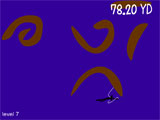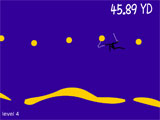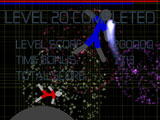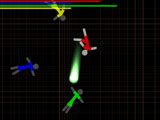Double Dose of Fun with Double Wires
Doubles Wires is a small Flash game by d_of_i, a Japanese developer best known for his Falling Sands game (as well as Cat Sledding and some other physics games and experiments). Despite its small scope and limited production value, I think Double Wires does some things very well. So well, in fact, that it deserves unique mention here on Fun-Motion.
[kml_flashembed movie=”/files/doublewires.swf” height=”360″ width=”480″ /]
The Lure of Dangling
Swinging titles are a common theme in physics games, for whatever reason. Personally, I think the attraction is two-fold. One: Actually swinging around on stuff–in real life–is a lot of fun. But, it’s damn hard. While your imagination may have you gliding from object to object with the greatest of ease, in practice it’s slow, clunky, and rather inelegant (plus, it requires a fair bit of strength, and sitting around on computers all day isn’t exactly building up that requirement). Two: There’s a primal attraction to the activity. I was watching an episode of the excellent Planet Earth with some great chimpanzee and monkey footage. I really did have the urge to spend the rest of the day in the jungle canopy, swinging carelessly from one branch to the next.
I’ve already talked about some of the swinging games out there (Rocky the Monkey, String Theory, Squishy the Starfish), and there a bunch of others I haven’t covered yet. So why talk about Double Wires?
Simplicity Trumps Again
What impresses me about Double Wires is how successfully it boils the swinging concept down to its minimum essentials. You simply click to attach a cable–which connects exactly where you pointed–and that’s it. Variables like controlling when a cable releases, its retraction speed, or maximum length are simply removed from the player’s hands. As a result, the game is distilled to a very pure swinging mechanic (in fact, there’s very little you can do in the game except swing on things).
Some subtle complexity remains, though. The two wires the stickman uses to swing around are actually different lengths. And the timing of the automatic release requires you pay careful attention to when you last connected to something. I often myself connecting above a point, wishing to swing below and then forward–what usually happens, though, is that my cable releases just as I reach the low point and my stick figure tumbles to a painful demise.


(Double Wires Game Screenshots)
Just Enough Content
There are 10 different zones in Double Wires, which last to somewhere around 140 yards. After that, the level simply loops back on itself and you start over. It won’t take a skilled player very long to complete all of the zones, but I’d be surprised if anyone was able to do it on their first try. The game is just short enough–and just fun enough–that it’s hard to resist retrying once or twice.
Play Double Wires (26 KB)
I’ve seen Double Wires embedded in various Flash arcades around the web, so I went ahead and included it here. Be sure to check out d_of_i’s other projects on his webpage, though. It can take some digging, but there are more excellent physics games to be discovered there…
Related Posts:
- List of Physics Games
- Turn-Based Pool Meets Rock-Paper-Scissors
- Great-Looking Motorcycle Game, But Is It Fun?
- Throw Metal Pies at Ragdoll Clowns (Redux)
- A Brilliant Physics Game: Ski Stunt Simulator
Interview: Fèlix Casablancas, BreakQuest
Fèlix Casablancas, creator of the best Breakout game of all time, BreakQuest, was kind enough to field a Fun-Motion interview. He covers the project’s inspiration, favorite BreakQuest level, his creative process and his future plans. Thanks again to Fèlix for his time!
Related Posts:
- The Pinnacle of Breakout Games: BreakQuest
- Play Physics Games? Like Taking Surveys?
- Fun-Motion Featured in The Wall Street Journal!
- List of Physics Games
- FAQ
Playground Soccer: Super Stealball
Super Stealball is a new game by Matteo Guarnieri of Rag Doll Software (makers of Ragdoll Masters–check out the game and interview here on the site). After a departure from ragdolls with N-Ball, Matteo has returned to his forte with a great use of the Ragdoll Masters engine. His site describes the game as:
Super Stealball is a crazy sports-like game in which players compete for the control of a ball. Ragdolls fly around in low gravity dribbling and tackling opponents in order to keep the ball of their colour.
Game Rules and Strategies
The rules of Super Stealball are simple. Each arena has 2-4 ragdolls and a ball. If you touch the ball it changes to your color until someone else touches it. Retain control of the ball for long enough and you pass the level.
These rules result in several viable strategies, depending on how many opponents you’re up against and the arena’s shape. In an open arena with smooth walls, you can simply try to keep the ball ahead and out of reach of your opponent by scooting along the outside way. Occasional direction changes will throw off the chase.
With more opponents, though, and in more irregularly-shaped arenas, your best bet is usually to hover around the ball and try to keep yourself between the ball and oncoming ragdolls. It’s much more like fending off attackers than it is playing keep-away.
Enemy AI
The AI in Super Stealball can be awfully crafty. The game gets harder by increasing the difficulty of the AI’s logic, rather than by cheating in some way. On the plus side, you can learn from the AI’s technique, but when you do lose it can be a tad frustrating. After all, the computer just beat you with the exact same capabilities you posses. Creating AI is one of the difficult challenges when it comes to creating physics games, and Matteo does this very well.
The AI seems to try position itself between you and the ball, and it does a pretty good job of doing so. It’s actually more difficult to combat in the one-on-one matches. When there are multiple opponents they each have their own color and don’t work together. As a result it’s easier to worm your way in and maximize your ball time, particularly because you can pick on whichever AI color is ahead.
Flow
Playing Super Stealball is an interesting exercise in flow. On occasion you will have a very articulated thought–crap, I need to stop Green from getting more ball time–but on the whole you generally achieve a state of flow and stare thoughtless at the monitor. It’s like playing in a very engaging physical sport. You simply do. When you’re “on” you know it. The enemy seems powerless to stop you, and you manage to dominate the match. It’s a rewarding feeling.


(Super Stealball Game Screenshots)
It’s a Steal
The full version of Super Stealball is priced at $9.95. At the time of this writing, though, the whole Rag Doll Software lineup is available half-price. Super Stealball is a great game to get in and out of quickly, and at $4.95 how can anyone resist?
Head on over to the Super Stealball page at Rag Doll Software to download the free demo (2.89 MB) or order the full version of this great physics game.
Related Posts:
- List of MacOS Physics Games
- List of Physics Games
- iPhone Physics Games Launch in July
- Excellent Marble Madness-Inspired Physics Game
- One-Part Tetris, One-Part Physics: Triptych


 (Rate this game! 269 votes, average: 3.99 out of 5)
(Rate this game! 269 votes, average: 3.99 out of 5)
 My name is Matthew Wegner, and this site is dedicated to physics games.
My name is Matthew Wegner, and this site is dedicated to physics games.